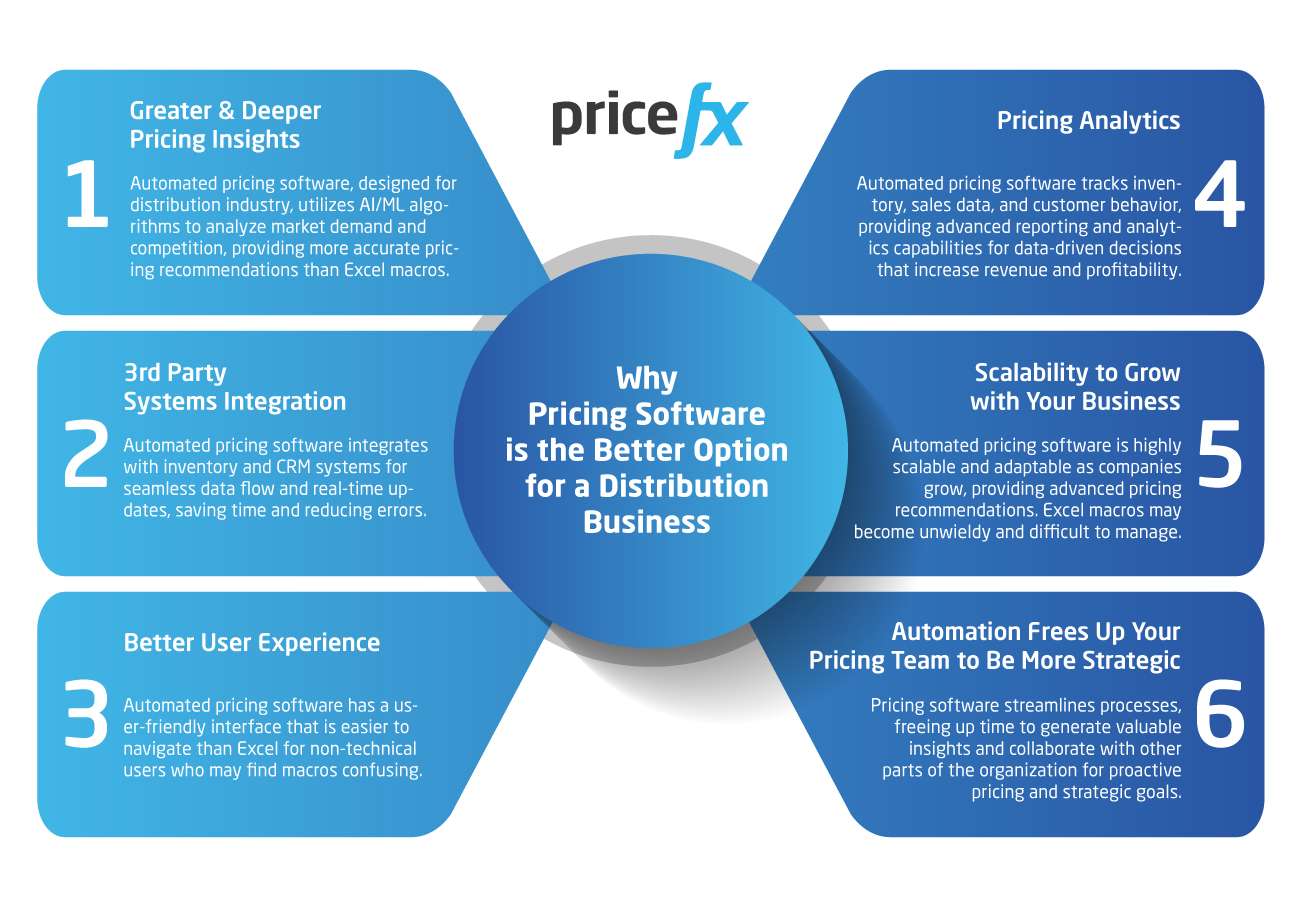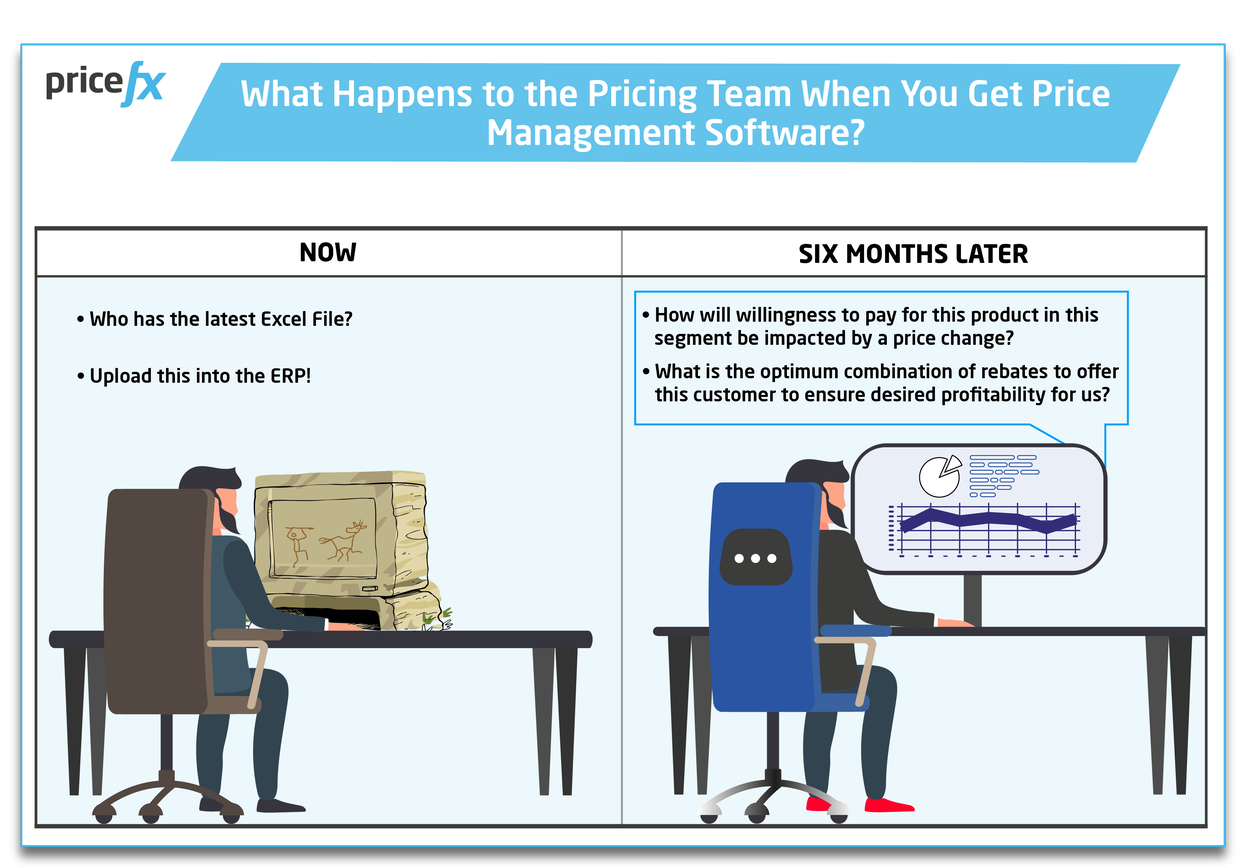The Best Pricing-Related Excel Macros for Distributors
May 15th, 2023 (Updated 06/14/2023) | 11 min. read
You might be wondering what the heck an automated pricing software vendor is doing writing an article about the best Excel macros for distributors. Well, let me tell you, we’re not just a bunch of computer nerds sitting around crunching numbers (okay, maybe we are, but that’s beside the point). As experts in the pricing game, we know that Excel macros can be important tools in a distributor’s arsenal. These handy little programs can help you simplify tasks, streamline processes, and ultimately boost profitability. So, buckle up and get prepared to learn about the best pricing-related Excel macros for distributors and applying them in the setting resale process – and get ready for more – you might be amazed to learn that there are more efficient and profitable ways of doing what a few lines of Excel formulas can do!
For more than a decade now, Pricefx has been assisting our distribution industry clients make informed pricing decisions in real-time, customized to their specific business requirements and goals. Our aim is to help distributors just like you protect your profits, help you manage your cost change challenges and supply you with the tools to transform into a cost-effective and agile pricing organization.
In this article, we will define Excel macros, provide a “best of” list of Excel macros that can help distributors optimize their setting resale process and also discuss a more automatic, stress-free, and error-prone process for managing the cost book resale process – pricing software.
Defining Excel Macros
Before we delve into the best Excel macros for the distribution industry, let’s first define what Excel macros are exactly.
Excel macros are a set of instructions that semi-automates repetitive tasks in Excel. They are created using Visual Basic for Applications (VBA), a programming language built into Excel. Macros can be used to automate almost any sequence of tasks in Excel, from something as simple as entering your company’s name and address into a spreadsheet to something as complex as creating a custom report. If you can do it in Excel, you can probably semi-automate it with a macro.

To use a macro in your Excel spreadsheet, you first need to record it. You perform the sequence of steps you eventually want to automate, and Excel will track them and save them in the macro. Once you’ve recorded your macro, you can run it again at any time. You can even assign a keyboard shortcut to access your chosen macros, to facilitate running it with just a few keystrokes.
Macros can save time and improve accuracy in your distribution company’s pricing-related Excel spreadsheets by performing complex calculations and data analysis automatically.
Excel macros are a popular tool for automating certain repetitive tasks, such as data entry or formatting. However, when it comes to more complex processes like pricing, they are only semi-automated.
While Excel macros can certainly help streamline certain pricing tasks, they lack the advanced level of automation achieved by AI (Artificial Intelligence) or machine learning informed pricing software. These technologies can analyze vast amounts of data, identify patterns, and adjust prices in real-time based on factors such as market demand, competitor pricing, and customer behavior.
In addition to greater automation, these technologies also provide a higher level of pricing insights, allowing businesses to optimize their pricing strategies and stay ahead of the competition. So, while Excel macros can be useful for basic tasks, when it comes to pricing, AI and machine learning technologies offer a much more advanced and comprehensive solution.
Defining the Setting Resale Process in the Distribution Industry
The setting resale process in distribution involves analyzing cost data to determine the optimal price for resale. This process includes calculating the cost of goods sold (COGS), overhead expenses, and profit margin.
Distributors must also consider market demand and competition when setting prices. The setting resale process can be time-consuming and complex, but Excel macros can simplify this process and save time.
In the pricing department of a distribution business, it is crucial to have a clear understanding of the resale process. Accurately pricing products is key to maximizing profit margins and maintaining a competitive edge in the market. The pricing department can use the data generated by the resale process to determine the most effective pricing strategies for different products and markets.
By utilizing Excel macros, the pricing department can automate and streamline the setting resale process, allowing them to focus on analyzing pricing trends and making informed decisions. This semi-automation can help to reduce errors and ensure consistency in pricing across the organization and assist the pricing department in working collaboratively with other departments such as sales and finance to ensure that pricing aligns with overall business objectives.
Best Excel Macros for the Distribution Industry
*It is important to note that while the use of Excel macros can greatly benefit the resale process, every company will have a different spreadsheet with customized layouts, columns, and rows. As such, we cannot provide an exact formula for each macro that can be simply copied and pasted into a company’s spreadsheet. The macros provided should be viewed as a guide to help companies begin to organize their setting resale process in Excel, and it will be necessary for each company to customize the macros to suit their specific needs. It is recommended that companies consult with an experienced Excel user to ensure that the macros are correctly implemented and aligned with their specific business requirements. Ultimately, it is up to each company to determine the best approach to implementing Excel macros in their cost book resale process.
Qualifications for the Best Excel Macros for the Distribution Industry
The Excel macros we have listed below can all help distributors using Excel in optimizing their setting resale process. To qualify for this ‘best of’ list, these macros must meet the following criteria:
- Efficiency: Macros must at least partially automate repetitive tasks and simplify complex calculations, saving time and improving accuracy.
- Relevance: Macros must be relevant to the cost book resale process in distribution, considering COGS, overhead expenses, profit margin, market demand, and competition.
- Customization: Macros must be customizable to fit the specific needs of each distributor and industry.
Here are 8 of the best macros to consider for inclusion to organize your company’s cost book and setting resale process
- COGS Macro: This macro automates the calculation of the cost of goods sold (COGS) for each product. In most industries, COGS considers the cost of raw materials, labor, and overhead expenses. However, specifically in the distribution industry, COGS is more simply considered to be the ‘cost of inventory’. For a distributor, COGS includes the cost of all inventory that was sold during the accounting period. However, in practice, distribution businesses often don’t know exactly which units of inventory were sold. Instead, they rely on accounting methods such as the first in, first out (FIFO) and last in, first out (LIFO) rules to estimate what value of inventory was actually sold during the period. This macro can save time and improve accuracy by eliminating the need to manually calculate COGS for each product.
- Profit Margin Macro: This macro calculates the profit margin for each product based on the desired profit percentage. Distributors can input the desired profit percentage, and the macro will calculate the selling price based on the COGS and profit margin. This macro can help distributors optimize their pricing strategy and maximize profits.
- Pricing Macro: This macro calculates the optimal price for resale based on market demand and competition. Distributors can input data on market demand and competitor pricing, and the macro will calculate the optimal price based on the COGS and profit margin. This macro can help distributors remain competitive and maximize profits.
- Inventory Macro: This macro tracks inventory levels and alerts distributors when inventory levels are low. It can also generate purchase orders automatically when inventory levels reach a certain threshold. This macro can help distributors optimize their inventory management and ensure they always have enough stock to meet demand.
- Shipping Macro: This macro calculates shipping costs based on the weight and destination of each product. It can also generate shipping labels automatically and track shipments in real time. This macro can help distributors optimize their shipping operations and reduce shipping costs.
- Forecasting Macro: This macro uses historical sales data to forecast future demand for each product. By analyzing trends and patterns in sales data, distributors can use this macro to predict future demand and adjust inventory levels accordingly. This can help distributors optimize their inventory management and reduce waste.
- Promotion Macro: This macro calculates the optimal price for products during promotional periods. By inputting data on promotional periods and discount rates, the macro can calculate the optimal price that balances maximizing revenue with minimizing profit margin erosion.
- Reporting Macro: This macro generates customizable reports on sales, inventory levels, and other key metrics. By automating the reporting process, distributors can save time and ensure accuracy when analyzing performance data. This macro can help distributors make data-driven decisions and identify areas for improvement.
By utilizing these and other Excel macros, distribution businesses can streamline their cost book and resale process and improve their pricing strategies. The macros semi-automate time-consuming tasks, reduce errors, and provide valuable insights that can help distributors optimize their inventory management, increase sales, and maximize profits.
Why Pricing Software is the Better Option for a Distribution Business
While Excel macros can certainly be useful in streamlining the setting resale and cost book processes an automated pricing software solution can do all the things described in the above list of macros better for several reasons:

1.Greater & Deeper Pricing Insights
An automated pricing software solution is specifically designed for the distribution industry and can provide more advanced features that Excel macros may not be able to provide. For example, an automated pricing software solution can utilize artificial intelligence machine learning algorithms to analyze market demand, competition, and other factors to provide more accurate pricing recommendations.
2. 3rd Party Systems Integration – Leads to Great Efficiency and Fewer Errors
Automated pricing software solutions can integrate with other software systems such as inventory management and CRM (Customer Relationship Management) systems. This integration allows for seamless data flow and real-time updates, reducing errors and saving time.
3. Better User Experience
Thirdly, an automated pricing software solution provides a more user-friendly interface that is easier to use and navigate than an Excel spreadsheet. This can be particularly important for non-technical users who may find Excel macros intimidating or confusing.
4. Pricing Analytics
An automated pricing software solution provides more advanced reporting and analytics capabilities. This allows distributors to not only track inventory levels and sales data but also to gain valuable insights into customer behavior, pricing trends, and other key metrics. These insights can help distributors make data-driven decisions that can increase revenue and profitability.
5. Scalability to Grow with Your Business
An automated pricing software solution is more scalable than Excel macros. As a company grows and adds more products or expands into new markets, an automated pricing software solution can easily adapt and provide more advanced pricing recommendations. Excel macros may become unwieldy and difficult to manage in such situations.
6. Automation Frees Up Your Pricing Team to Be More Strategic
As discussed, pricing software will streamline all your current processes, significantly reducing the amount of time your team wastes getting lost in Excel files and plotting data points. This frees up their time and energy to focus on leveraging the tools of your new solution to identify better, more strategic areas of opportunity.

Uncovering new opportunities will immediately generate insights (more challenging, creative, career-defining work) for your team that translates much better into value for your business. What’s more, they’ll start connecting and collaborating with other parts of the organization, like Purchasing to enable even more proactive pricing around cost changes, or Finance, concentrating on strategic goals.
What Does Pricefx Have to Offer to My Distribution Company?
Now you know the macros that may assist in your distribution company’s Excel pricing processes. If you have the resources, this article may have helped you realize that an automated pricing software solution like Pricefx could make the process faster, easier, and more insightful for your distribution business.
Check out this handy article below to learn the top features Pricefx pricing software offers specifically for a distributor like you:
Or if you would like to learn more on the entire range of pricing solutions options, learn more here about how to choose the best pricing software for your business.
Happy Pricing!

